Promoting Positive Medication Behaviour in Social Care Sectors
VerifiedAdded on 2020/06/04
|9
|2242
|25
Report
AI Summary
This report provides a comprehensive overview of promoting positive medication behaviour within social care sectors, focusing on the National Health Service (NHS) in the UK. It details current legislation and policies, including The Controlled Drugs Regulations 2013 and The Misuse of Drugs Act 2001, emphasizing their importance in safe drug management. The report outlines the roles and responsibilities of healthcare professionals involved in medication support, such as practitioners, nurses, and pharmacists, highlighting their duties in patient care, knowledge of side effects, and administration techniques. It explains methods to access patient medication information, including the Medication Administration Record (MAR) and care plans. Different routes of medication administration and various forms of medication presentation are described, along with the use of assistive equipment. Data recording practices, safe storage guidelines, and procedures for disposing of unused or unwanted medications are also thoroughly addressed, ensuring patient safety and medication efficacy. The report concludes by emphasizing the importance of a strong patient-doctor relationship for effective treatment and the need for safe medication handling practices.
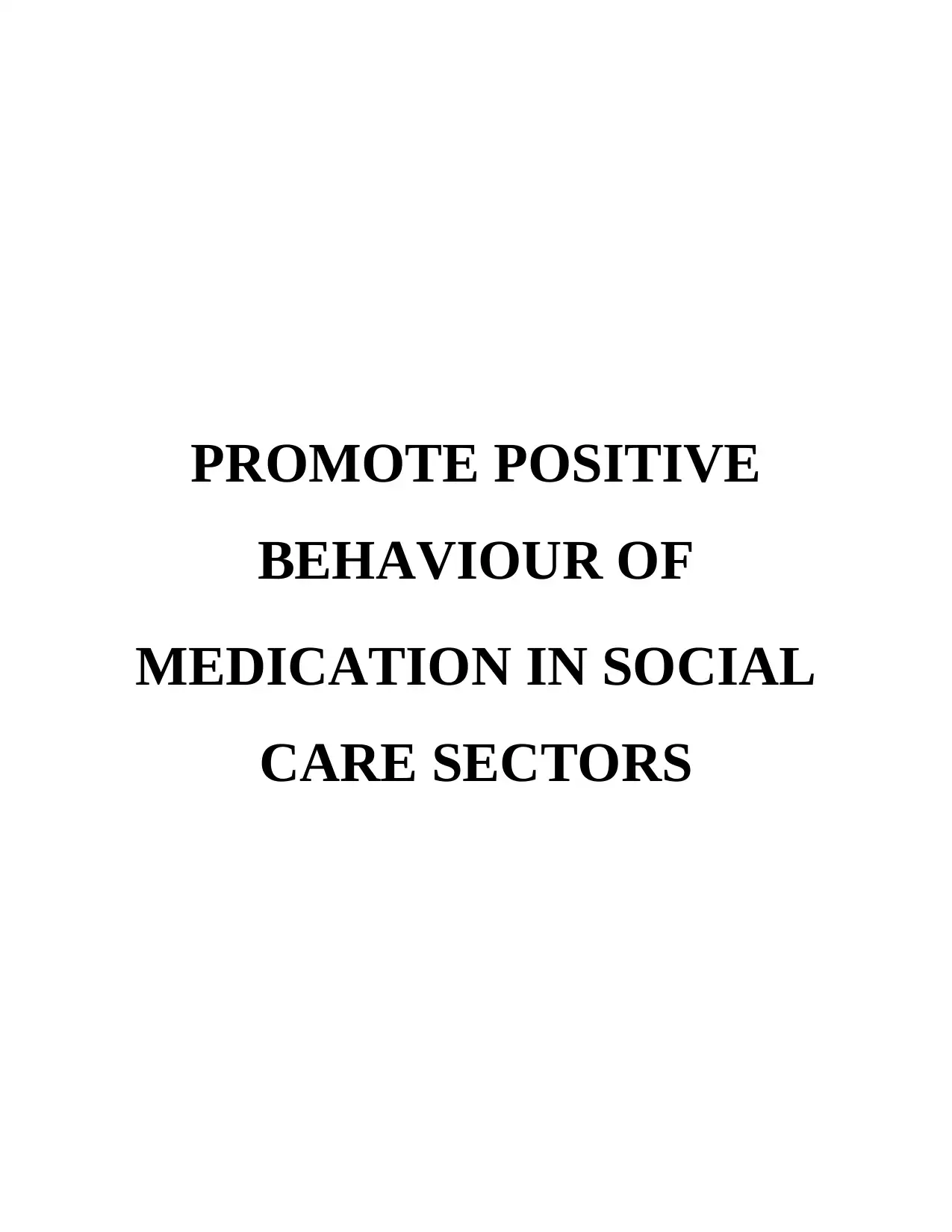
PROMOTE POSITIVE
BEHAVIOUR OF
MEDICATION IN SOCIAL
CARE SECTORS
BEHAVIOUR OF
MEDICATION IN SOCIAL
CARE SECTORS
Paraphrase This Document
Need a fresh take? Get an instant paraphrase of this document with our AI Paraphraser
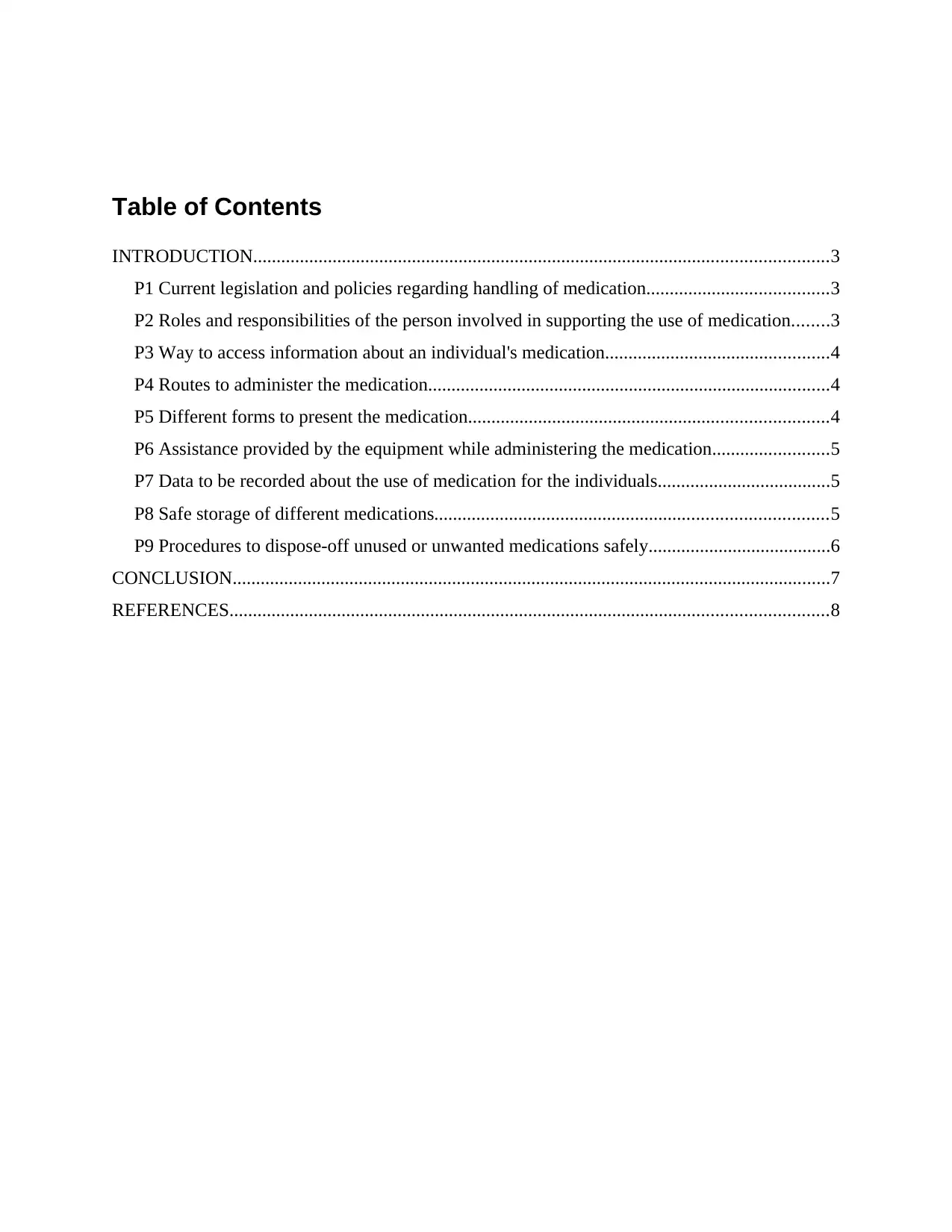
Table of Contents
INTRODUCTION...........................................................................................................................3
P1 Current legislation and policies regarding handling of medication.......................................3
P2 Roles and responsibilities of the person involved in supporting the use of medication........3
P3 Way to access information about an individual's medication................................................4
P4 Routes to administer the medication......................................................................................4
P5 Different forms to present the medication.............................................................................4
P6 Assistance provided by the equipment while administering the medication.........................5
P7 Data to be recorded about the use of medication for the individuals.....................................5
P8 Safe storage of different medications....................................................................................5
P9 Procedures to dispose-off unused or unwanted medications safely.......................................6
CONCLUSION................................................................................................................................7
REFERENCES................................................................................................................................8
INTRODUCTION...........................................................................................................................3
P1 Current legislation and policies regarding handling of medication.......................................3
P2 Roles and responsibilities of the person involved in supporting the use of medication........3
P3 Way to access information about an individual's medication................................................4
P4 Routes to administer the medication......................................................................................4
P5 Different forms to present the medication.............................................................................4
P6 Assistance provided by the equipment while administering the medication.........................5
P7 Data to be recorded about the use of medication for the individuals.....................................5
P8 Safe storage of different medications....................................................................................5
P9 Procedures to dispose-off unused or unwanted medications safely.......................................6
CONCLUSION................................................................................................................................7
REFERENCES................................................................................................................................8
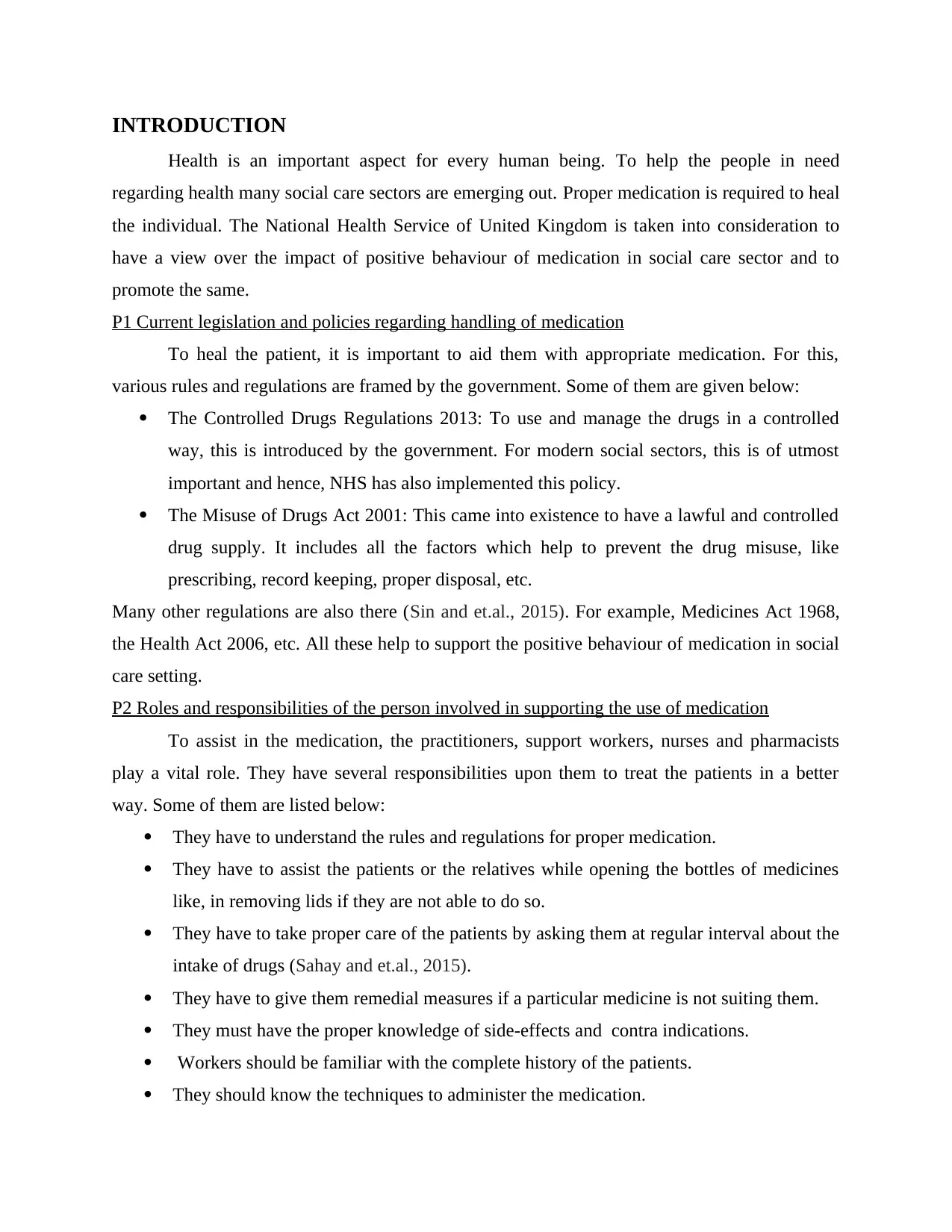
INTRODUCTION
Health is an important aspect for every human being. To help the people in need
regarding health many social care sectors are emerging out. Proper medication is required to heal
the individual. The National Health Service of United Kingdom is taken into consideration to
have a view over the impact of positive behaviour of medication in social care sector and to
promote the same.
P1 Current legislation and policies regarding handling of medication
To heal the patient, it is important to aid them with appropriate medication. For this,
various rules and regulations are framed by the government. Some of them are given below:
The Controlled Drugs Regulations 2013: To use and manage the drugs in a controlled
way, this is introduced by the government. For modern social sectors, this is of utmost
important and hence, NHS has also implemented this policy.
The Misuse of Drugs Act 2001: This came into existence to have a lawful and controlled
drug supply. It includes all the factors which help to prevent the drug misuse, like
prescribing, record keeping, proper disposal, etc.
Many other regulations are also there (Sin and et.al., 2015). For example, Medicines Act 1968,
the Health Act 2006, etc. All these help to support the positive behaviour of medication in social
care setting.
P2 Roles and responsibilities of the person involved in supporting the use of medication
To assist in the medication, the practitioners, support workers, nurses and pharmacists
play a vital role. They have several responsibilities upon them to treat the patients in a better
way. Some of them are listed below:
They have to understand the rules and regulations for proper medication.
They have to assist the patients or the relatives while opening the bottles of medicines
like, in removing lids if they are not able to do so.
They have to take proper care of the patients by asking them at regular interval about the
intake of drugs (Sahay and et.al., 2015).
They have to give them remedial measures if a particular medicine is not suiting them.
They must have the proper knowledge of side-effects and contra indications.
Workers should be familiar with the complete history of the patients.
They should know the techniques to administer the medication.
Health is an important aspect for every human being. To help the people in need
regarding health many social care sectors are emerging out. Proper medication is required to heal
the individual. The National Health Service of United Kingdom is taken into consideration to
have a view over the impact of positive behaviour of medication in social care sector and to
promote the same.
P1 Current legislation and policies regarding handling of medication
To heal the patient, it is important to aid them with appropriate medication. For this,
various rules and regulations are framed by the government. Some of them are given below:
The Controlled Drugs Regulations 2013: To use and manage the drugs in a controlled
way, this is introduced by the government. For modern social sectors, this is of utmost
important and hence, NHS has also implemented this policy.
The Misuse of Drugs Act 2001: This came into existence to have a lawful and controlled
drug supply. It includes all the factors which help to prevent the drug misuse, like
prescribing, record keeping, proper disposal, etc.
Many other regulations are also there (Sin and et.al., 2015). For example, Medicines Act 1968,
the Health Act 2006, etc. All these help to support the positive behaviour of medication in social
care setting.
P2 Roles and responsibilities of the person involved in supporting the use of medication
To assist in the medication, the practitioners, support workers, nurses and pharmacists
play a vital role. They have several responsibilities upon them to treat the patients in a better
way. Some of them are listed below:
They have to understand the rules and regulations for proper medication.
They have to assist the patients or the relatives while opening the bottles of medicines
like, in removing lids if they are not able to do so.
They have to take proper care of the patients by asking them at regular interval about the
intake of drugs (Sahay and et.al., 2015).
They have to give them remedial measures if a particular medicine is not suiting them.
They must have the proper knowledge of side-effects and contra indications.
Workers should be familiar with the complete history of the patients.
They should know the techniques to administer the medication.
⊘ This is a preview!⊘
Do you want full access?
Subscribe today to unlock all pages.

Trusted by 1+ million students worldwide
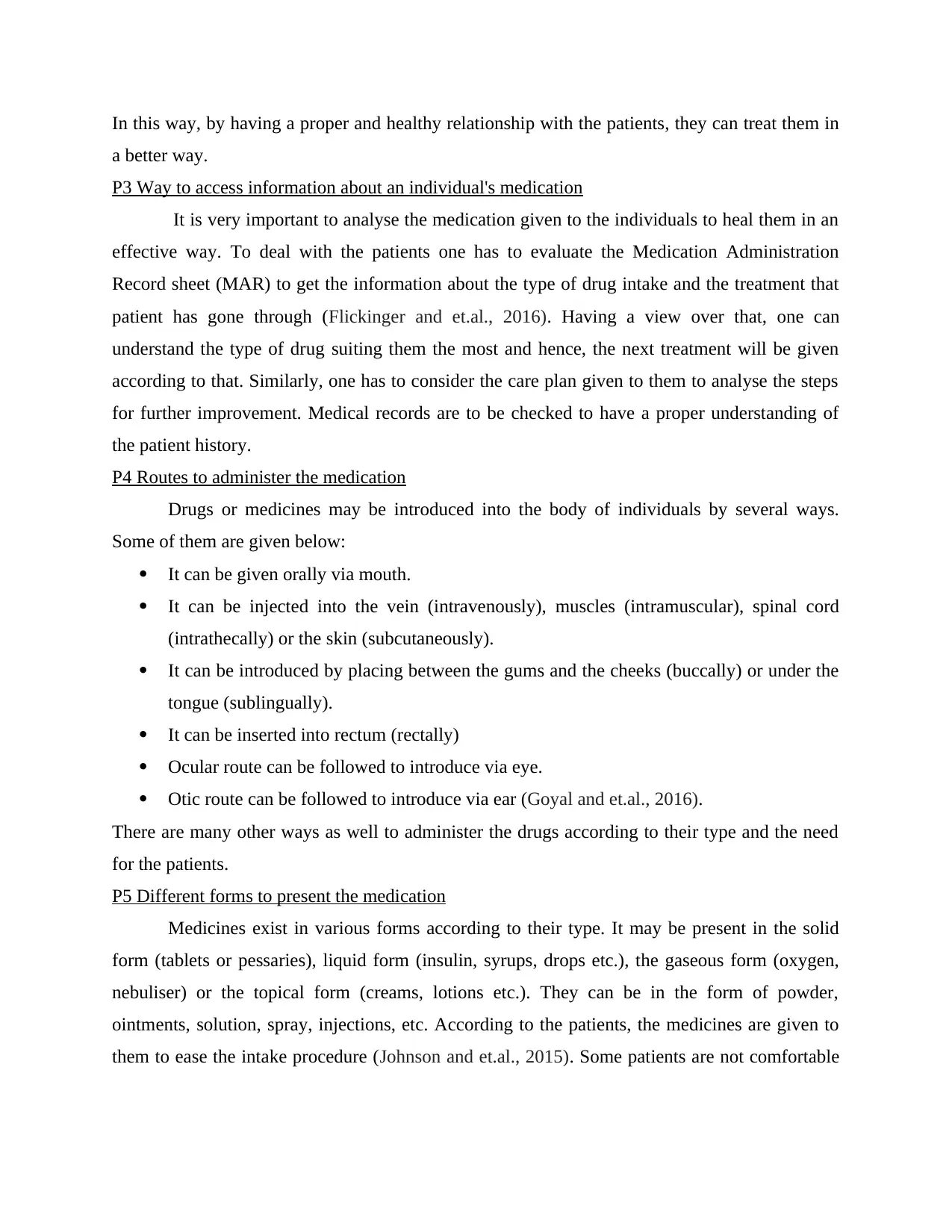
In this way, by having a proper and healthy relationship with the patients, they can treat them in
a better way.
P3 Way to access information about an individual's medication
It is very important to analyse the medication given to the individuals to heal them in an
effective way. To deal with the patients one has to evaluate the Medication Administration
Record sheet (MAR) to get the information about the type of drug intake and the treatment that
patient has gone through (Flickinger and et.al., 2016). Having a view over that, one can
understand the type of drug suiting them the most and hence, the next treatment will be given
according to that. Similarly, one has to consider the care plan given to them to analyse the steps
for further improvement. Medical records are to be checked to have a proper understanding of
the patient history.
P4 Routes to administer the medication
Drugs or medicines may be introduced into the body of individuals by several ways.
Some of them are given below:
It can be given orally via mouth.
It can be injected into the vein (intravenously), muscles (intramuscular), spinal cord
(intrathecally) or the skin (subcutaneously).
It can be introduced by placing between the gums and the cheeks (buccally) or under the
tongue (sublingually).
It can be inserted into rectum (rectally)
Ocular route can be followed to introduce via eye.
Otic route can be followed to introduce via ear (Goyal and et.al., 2016).
There are many other ways as well to administer the drugs according to their type and the need
for the patients.
P5 Different forms to present the medication
Medicines exist in various forms according to their type. It may be present in the solid
form (tablets or pessaries), liquid form (insulin, syrups, drops etc.), the gaseous form (oxygen,
nebuliser) or the topical form (creams, lotions etc.). They can be in the form of powder,
ointments, solution, spray, injections, etc. According to the patients, the medicines are given to
them to ease the intake procedure (Johnson and et.al., 2015). Some patients are not comfortable
a better way.
P3 Way to access information about an individual's medication
It is very important to analyse the medication given to the individuals to heal them in an
effective way. To deal with the patients one has to evaluate the Medication Administration
Record sheet (MAR) to get the information about the type of drug intake and the treatment that
patient has gone through (Flickinger and et.al., 2016). Having a view over that, one can
understand the type of drug suiting them the most and hence, the next treatment will be given
according to that. Similarly, one has to consider the care plan given to them to analyse the steps
for further improvement. Medical records are to be checked to have a proper understanding of
the patient history.
P4 Routes to administer the medication
Drugs or medicines may be introduced into the body of individuals by several ways.
Some of them are given below:
It can be given orally via mouth.
It can be injected into the vein (intravenously), muscles (intramuscular), spinal cord
(intrathecally) or the skin (subcutaneously).
It can be introduced by placing between the gums and the cheeks (buccally) or under the
tongue (sublingually).
It can be inserted into rectum (rectally)
Ocular route can be followed to introduce via eye.
Otic route can be followed to introduce via ear (Goyal and et.al., 2016).
There are many other ways as well to administer the drugs according to their type and the need
for the patients.
P5 Different forms to present the medication
Medicines exist in various forms according to their type. It may be present in the solid
form (tablets or pessaries), liquid form (insulin, syrups, drops etc.), the gaseous form (oxygen,
nebuliser) or the topical form (creams, lotions etc.). They can be in the form of powder,
ointments, solution, spray, injections, etc. According to the patients, the medicines are given to
them to ease the intake procedure (Johnson and et.al., 2015). Some patients are not comfortable
Paraphrase This Document
Need a fresh take? Get an instant paraphrase of this document with our AI Paraphraser
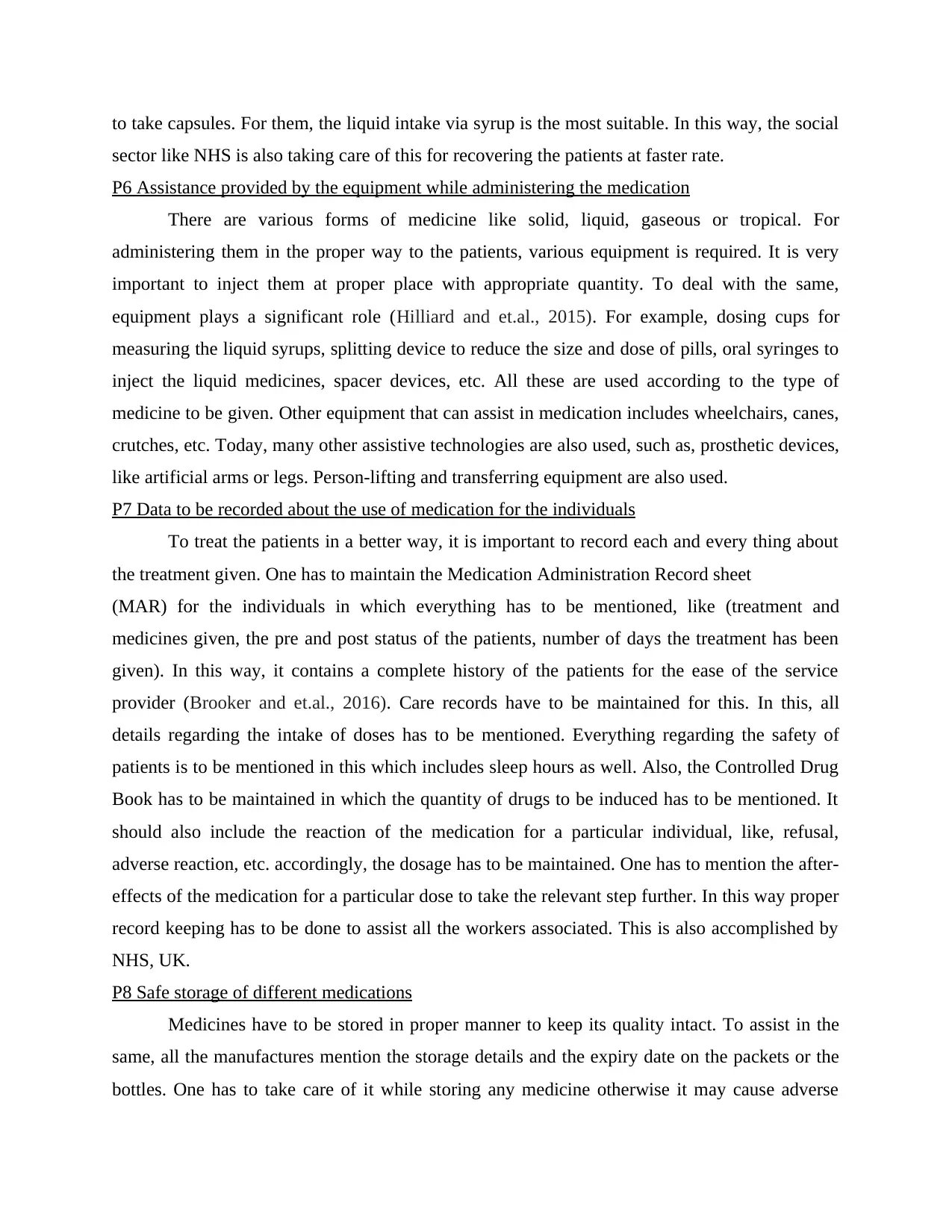
to take capsules. For them, the liquid intake via syrup is the most suitable. In this way, the social
sector like NHS is also taking care of this for recovering the patients at faster rate.
P6 Assistance provided by the equipment while administering the medication
There are various forms of medicine like solid, liquid, gaseous or tropical. For
administering them in the proper way to the patients, various equipment is required. It is very
important to inject them at proper place with appropriate quantity. To deal with the same,
equipment plays a significant role (Hilliard and et.al., 2015). For example, dosing cups for
measuring the liquid syrups, splitting device to reduce the size and dose of pills, oral syringes to
inject the liquid medicines, spacer devices, etc. All these are used according to the type of
medicine to be given. Other equipment that can assist in medication includes wheelchairs, canes,
crutches, etc. Today, many other assistive technologies are also used, such as, prosthetic devices,
like artificial arms or legs. Person-lifting and transferring equipment are also used.
P7 Data to be recorded about the use of medication for the individuals
To treat the patients in a better way, it is important to record each and every thing about
the treatment given. One has to maintain the Medication Administration Record sheet
(MAR) for the individuals in which everything has to be mentioned, like (treatment and
medicines given, the pre and post status of the patients, number of days the treatment has been
given). In this way, it contains a complete history of the patients for the ease of the service
provider (Brooker and et.al., 2016). Care records have to be maintained for this. In this, all
details regarding the intake of doses has to be mentioned. Everything regarding the safety of
patients is to be mentioned in this which includes sleep hours as well. Also, the Controlled Drug
Book has to be maintained in which the quantity of drugs to be induced has to be mentioned. It
should also include the reaction of the medication for a particular individual, like, refusal,
adverse reaction, etc. accordingly, the dosage has to be maintained. One has to mention the after-
effects of the medication for a particular dose to take the relevant step further. In this way proper
record keeping has to be done to assist all the workers associated. This is also accomplished by
NHS, UK.
P8 Safe storage of different medications
Medicines have to be stored in proper manner to keep its quality intact. To assist in the
same, all the manufactures mention the storage details and the expiry date on the packets or the
bottles. One has to take care of it while storing any medicine otherwise it may cause adverse
sector like NHS is also taking care of this for recovering the patients at faster rate.
P6 Assistance provided by the equipment while administering the medication
There are various forms of medicine like solid, liquid, gaseous or tropical. For
administering them in the proper way to the patients, various equipment is required. It is very
important to inject them at proper place with appropriate quantity. To deal with the same,
equipment plays a significant role (Hilliard and et.al., 2015). For example, dosing cups for
measuring the liquid syrups, splitting device to reduce the size and dose of pills, oral syringes to
inject the liquid medicines, spacer devices, etc. All these are used according to the type of
medicine to be given. Other equipment that can assist in medication includes wheelchairs, canes,
crutches, etc. Today, many other assistive technologies are also used, such as, prosthetic devices,
like artificial arms or legs. Person-lifting and transferring equipment are also used.
P7 Data to be recorded about the use of medication for the individuals
To treat the patients in a better way, it is important to record each and every thing about
the treatment given. One has to maintain the Medication Administration Record sheet
(MAR) for the individuals in which everything has to be mentioned, like (treatment and
medicines given, the pre and post status of the patients, number of days the treatment has been
given). In this way, it contains a complete history of the patients for the ease of the service
provider (Brooker and et.al., 2016). Care records have to be maintained for this. In this, all
details regarding the intake of doses has to be mentioned. Everything regarding the safety of
patients is to be mentioned in this which includes sleep hours as well. Also, the Controlled Drug
Book has to be maintained in which the quantity of drugs to be induced has to be mentioned. It
should also include the reaction of the medication for a particular individual, like, refusal,
adverse reaction, etc. accordingly, the dosage has to be maintained. One has to mention the after-
effects of the medication for a particular dose to take the relevant step further. In this way proper
record keeping has to be done to assist all the workers associated. This is also accomplished by
NHS, UK.
P8 Safe storage of different medications
Medicines have to be stored in proper manner to keep its quality intact. To assist in the
same, all the manufactures mention the storage details and the expiry date on the packets or the
bottles. One has to take care of it while storing any medicine otherwise it may cause adverse
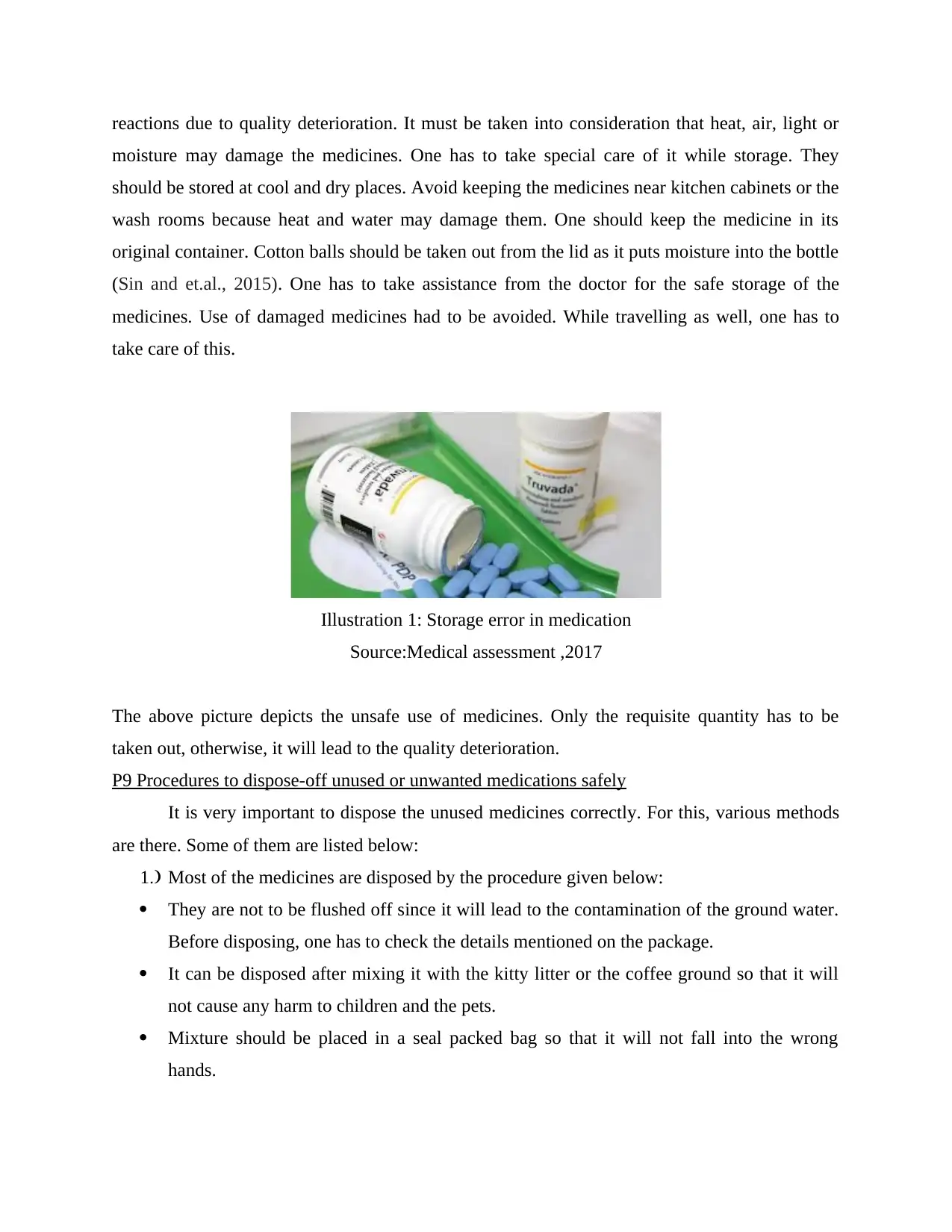
reactions due to quality deterioration. It must be taken into consideration that heat, air, light or
moisture may damage the medicines. One has to take special care of it while storage. They
should be stored at cool and dry places. Avoid keeping the medicines near kitchen cabinets or the
wash rooms because heat and water may damage them. One should keep the medicine in its
original container. Cotton balls should be taken out from the lid as it puts moisture into the bottle
(Sin and et.al., 2015). One has to take assistance from the doctor for the safe storage of the
medicines. Use of damaged medicines had to be avoided. While travelling as well, one has to
take care of this.
The above picture depicts the unsafe use of medicines. Only the requisite quantity has to be
taken out, otherwise, it will lead to the quality deterioration.
P9 Procedures to dispose-off unused or unwanted medications safely
It is very important to dispose the unused medicines correctly. For this, various methods
are there. Some of them are listed below:
1.) Most of the medicines are disposed by the procedure given below:
They are not to be flushed off since it will lead to the contamination of the ground water.
Before disposing, one has to check the details mentioned on the package.
It can be disposed after mixing it with the kitty litter or the coffee ground so that it will
not cause any harm to children and the pets.
Mixture should be placed in a seal packed bag so that it will not fall into the wrong
hands.
Illustration 1: Storage error in medication
Source:Medical assessment ,2017
moisture may damage the medicines. One has to take special care of it while storage. They
should be stored at cool and dry places. Avoid keeping the medicines near kitchen cabinets or the
wash rooms because heat and water may damage them. One should keep the medicine in its
original container. Cotton balls should be taken out from the lid as it puts moisture into the bottle
(Sin and et.al., 2015). One has to take assistance from the doctor for the safe storage of the
medicines. Use of damaged medicines had to be avoided. While travelling as well, one has to
take care of this.
The above picture depicts the unsafe use of medicines. Only the requisite quantity has to be
taken out, otherwise, it will lead to the quality deterioration.
P9 Procedures to dispose-off unused or unwanted medications safely
It is very important to dispose the unused medicines correctly. For this, various methods
are there. Some of them are listed below:
1.) Most of the medicines are disposed by the procedure given below:
They are not to be flushed off since it will lead to the contamination of the ground water.
Before disposing, one has to check the details mentioned on the package.
It can be disposed after mixing it with the kitty litter or the coffee ground so that it will
not cause any harm to children and the pets.
Mixture should be placed in a seal packed bag so that it will not fall into the wrong
hands.
Illustration 1: Storage error in medication
Source:Medical assessment ,2017
⊘ This is a preview!⊘
Do you want full access?
Subscribe today to unlock all pages.

Trusted by 1+ million students worldwide
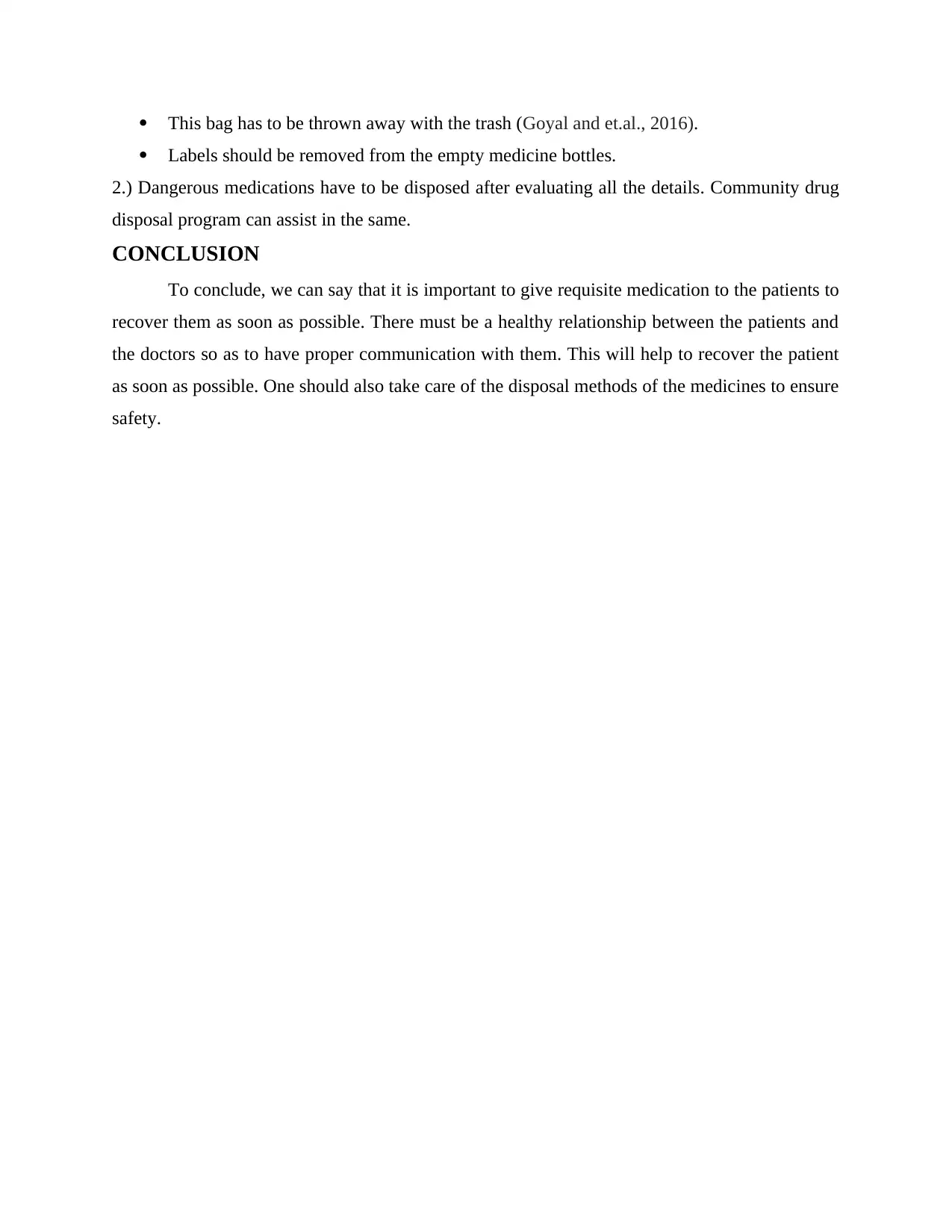
This bag has to be thrown away with the trash (Goyal and et.al., 2016).
Labels should be removed from the empty medicine bottles.
2.) Dangerous medications have to be disposed after evaluating all the details. Community drug
disposal program can assist in the same.
CONCLUSION
To conclude, we can say that it is important to give requisite medication to the patients to
recover them as soon as possible. There must be a healthy relationship between the patients and
the doctors so as to have proper communication with them. This will help to recover the patient
as soon as possible. One should also take care of the disposal methods of the medicines to ensure
safety.
Labels should be removed from the empty medicine bottles.
2.) Dangerous medications have to be disposed after evaluating all the details. Community drug
disposal program can assist in the same.
CONCLUSION
To conclude, we can say that it is important to give requisite medication to the patients to
recover them as soon as possible. There must be a healthy relationship between the patients and
the doctors so as to have proper communication with them. This will help to recover the patient
as soon as possible. One should also take care of the disposal methods of the medicines to ensure
safety.
Paraphrase This Document
Need a fresh take? Get an instant paraphrase of this document with our AI Paraphraser
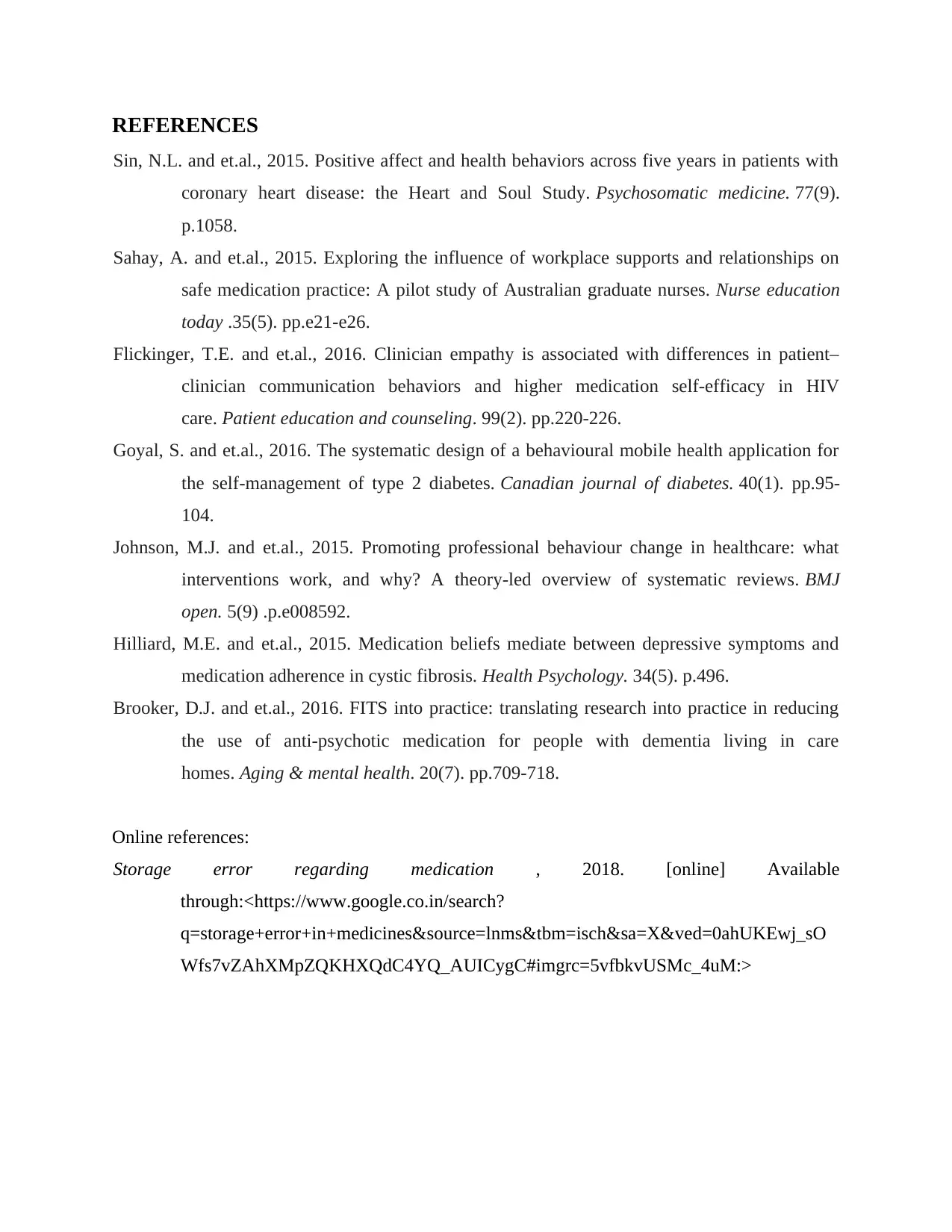
REFERENCES
Sin, N.L. and et.al., 2015. Positive affect and health behaviors across five years in patients with
coronary heart disease: the Heart and Soul Study. Psychosomatic medicine. 77(9).
p.1058.
Sahay, A. and et.al., 2015. Exploring the influence of workplace supports and relationships on
safe medication practice: A pilot study of Australian graduate nurses. Nurse education
today .35(5). pp.e21-e26.
Flickinger, T.E. and et.al., 2016. Clinician empathy is associated with differences in patient–
clinician communication behaviors and higher medication self-efficacy in HIV
care. Patient education and counseling. 99(2). pp.220-226.
Goyal, S. and et.al., 2016. The systematic design of a behavioural mobile health application for
the self-management of type 2 diabetes. Canadian journal of diabetes. 40(1). pp.95-
104.
Johnson, M.J. and et.al., 2015. Promoting professional behaviour change in healthcare: what
interventions work, and why? A theory-led overview of systematic reviews. BMJ
open. 5(9) .p.e008592.
Hilliard, M.E. and et.al., 2015. Medication beliefs mediate between depressive symptoms and
medication adherence in cystic fibrosis. Health Psychology. 34(5). p.496.
Brooker, D.J. and et.al., 2016. FITS into practice: translating research into practice in reducing
the use of anti-psychotic medication for people with dementia living in care
homes. Aging & mental health. 20(7). pp.709-718.
Online references:
Storage error regarding medication , 2018. [online] Available
through:<https://www.google.co.in/search?
q=storage+error+in+medicines&source=lnms&tbm=isch&sa=X&ved=0ahUKEwj_sO
Wfs7vZAhXMpZQKHXQdC4YQ_AUICygC#imgrc=5vfbkvUSMc_4uM:>
Sin, N.L. and et.al., 2015. Positive affect and health behaviors across five years in patients with
coronary heart disease: the Heart and Soul Study. Psychosomatic medicine. 77(9).
p.1058.
Sahay, A. and et.al., 2015. Exploring the influence of workplace supports and relationships on
safe medication practice: A pilot study of Australian graduate nurses. Nurse education
today .35(5). pp.e21-e26.
Flickinger, T.E. and et.al., 2016. Clinician empathy is associated with differences in patient–
clinician communication behaviors and higher medication self-efficacy in HIV
care. Patient education and counseling. 99(2). pp.220-226.
Goyal, S. and et.al., 2016. The systematic design of a behavioural mobile health application for
the self-management of type 2 diabetes. Canadian journal of diabetes. 40(1). pp.95-
104.
Johnson, M.J. and et.al., 2015. Promoting professional behaviour change in healthcare: what
interventions work, and why? A theory-led overview of systematic reviews. BMJ
open. 5(9) .p.e008592.
Hilliard, M.E. and et.al., 2015. Medication beliefs mediate between depressive symptoms and
medication adherence in cystic fibrosis. Health Psychology. 34(5). p.496.
Brooker, D.J. and et.al., 2016. FITS into practice: translating research into practice in reducing
the use of anti-psychotic medication for people with dementia living in care
homes. Aging & mental health. 20(7). pp.709-718.
Online references:
Storage error regarding medication , 2018. [online] Available
through:<https://www.google.co.in/search?
q=storage+error+in+medicines&source=lnms&tbm=isch&sa=X&ved=0ahUKEwj_sO
Wfs7vZAhXMpZQKHXQdC4YQ_AUICygC#imgrc=5vfbkvUSMc_4uM:>

⊘ This is a preview!⊘
Do you want full access?
Subscribe today to unlock all pages.

Trusted by 1+ million students worldwide
1 out of 9
Related Documents
Your All-in-One AI-Powered Toolkit for Academic Success.
+13062052269
info@desklib.com
Available 24*7 on WhatsApp / Email
![[object Object]](/_next/static/media/star-bottom.7253800d.svg)
Unlock your academic potential
Copyright © 2020–2025 A2Z Services. All Rights Reserved. Developed and managed by ZUCOL.





